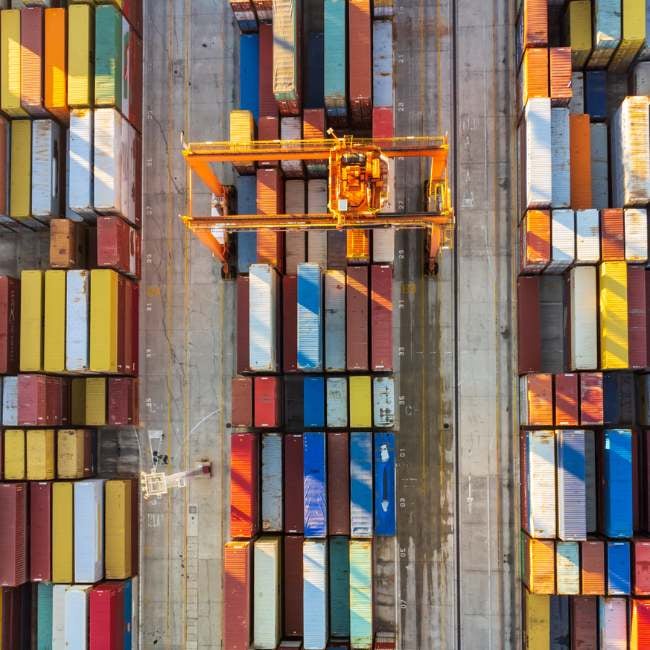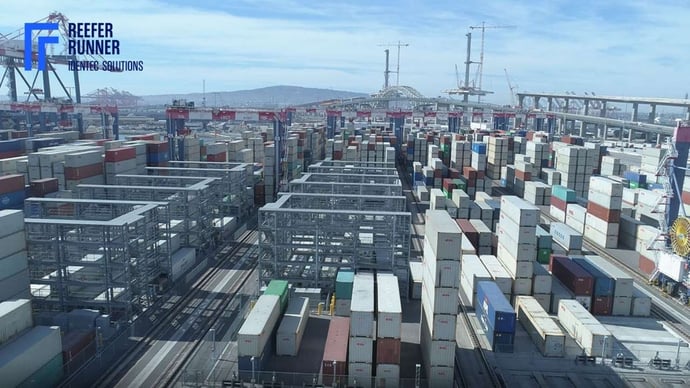Automated Refrigerated Container Monitoring on Deep Sea Vessels
| Written by Dr. Urban Siller
Higher service quality comes at lower cost while improving the environmental footprint. Deep sea container vessels are going digital – cruising levels, speed profiles, consumption of main and auxiliary engines, operation profiles, dynamic trim and real-time energy monitoring systems – nowadays everything is visible in onshore based vessel coordination centers and on board as well.

No video selected
Select a video type in the sidebar.
HOW ABOUT TEMPERATURE CONTROLLED CONTAINER (“REEFER”) MANAGEMENT?
Today, onshore container terminal operators invest in fully automated reefer monitoring solutions. These systems allow remote monitoring of temperature, air flow, humidity, power consumption and up to forty more parameters plus alarms and to archive data for reports, analyses and claim management directly linked to their Terminal Operating Systems.
On container vessels, it is still common practice to patrol every twelve hours all bays and decks to check each reefer and record its temperature via a paper & pencil process, archiving these reports in filing folders for up to ten years. Deviations from cargo owner requirements are rarely included in daily noon reports and patrolling on board during heavy sea may cause Health & Safety issues for the crew.
A surprising fact, since the number of live reefers on a vessel and a container terminal are in the same order of magnitude. Large vessels have the capacity to carry up to 2’000 powered reefer containers whereas the largest terminals can hold up to 5’000 live reefer containers.
So far, the approach by shipping lines has been to make the reefer container smart. Hamburg Süd, Maersk Line and other shipping companies retrofitted their reefer fleet with power line or GSM based modems in an expensive and time-consuming fleet conversion exercise.
WHY IS THE OUTCOME STILL DISSATISFACTORY COMPARED TO THE COST AND EFFORT OF THE FLEET CONVERSION?
With the increase of consolidation in international container shipping the percentage of fleet converted reefers compared to containers without a modem for automatic monitoring decreased continuously. Typically, this ratio is today down to around 25 % which requires the crew to monitor up to 75 % of the live reefers manually. With such a low automation ratio the crew continues to invest a lot of time in manual monitoring.
A second drawback comes from the chosen technology. Power line based reefer monitoring systems communicate via the 400 Volt power supply network onboard. These systems work up to a certain number of cool containers however have bandwidth problems on large vessels with a high number of live reefers. Since vessels tend to get bigger and the reefer market grows faster than the dry container market, this technology seems to be running into scaling problems.
GSM based modems communicate with a vessel based GSM receiver that must be switched off within the twelve-mile zone. This requires the crew to monitor all containers manually within the twelve-mile zone since reliable GSM communication with land-based infrastructure is not possible through the steel structure of a ship. The cellular coverage of national network providers does not cover the boundaries of the twelve-mile zone, especially for containers stowed under deck.
Furthermore, not all these systems are targeted to deliver data for the vessel coordination centre and the crew. Some systems are designed mainly for control centre purposes and only deliver data to the crew once in 24 hours, making manual monitoring irreplaceable.
A third aspect that limits the distribution of container mounted reefer monitoring systems in general is the lack of operational ownership, especially for maintenance and repair. Most, if not all, systems that got retrofitted in the past deteriorated overtime in their monitoring capability because broken power line or GSM modems didn’t get maintained. This should not be read as criticism it is simply an outcome of the separation between the party who owns the reefer and the party who is in the temporary possession of the cool container in today’s global supply chain.
Refrigerated Container Monitoring
Automated reefer monitoring systems on deep-sea vessels should be developed with the target to solve the operational problems the crew is confronted with during every single trip while delivering data onshore simultaneously:
Ships need a minimum crew to sail safely. If this minimum crew gets charged with too many add-on tasks, service quality is going to suffer. As an example, it is not feasible to prioritize between vessel maintenance and reefer monitoring tasks. Both require equal attention and must get carried out in parallel.
Today’s approaches are to handle both tasks by tight crew management or to sacrifice on vessel maintenance within the legal framework and engage so-called “riding crews” who sail with the vessel from time to time for a more thorough brush up of the ship. Alternatively, some shipping lines expand the crew above the minimum crew requirement bearing additional personnel cost to guarantee an outstanding reefer service quality without claims to their customers.
With a suitable automated refrigerated container monitoring system onboard, these operational issues vanish while providing additional benefits that contribute to the profitability and the environmental footprint of shipping lines:
Carrying special cargo such as avocados, blood plasma and alike becomes possible without additional cost or effort for the crew while complying with even the most rigid monitoring and documentation requirements of cargo owners.
In other words, special cargo is no longer a burden but revenue and profit generator and shall get acquired actively by the sales team of a shipping line competing against air freight whenever possible.
Systems that can report reefer data in intervals of 15 minutes or less provide real-time data of the cool container 24/7 and overfulfill the most extreme monitoring requirements. Real-time based reefer monitoring systems allow the transportation of highly sensitive commodities at no additional OPEX for monitoring and documentation.
If the reefer monitoring system is capable to measure the power consumption of every single container without additional hardware like add-on power meters it is possible to detect where the onshore pre-cooling process wasn’t completed. It is now the duty of the vessel to cool down the commodity to the setpoint temperature.
Live data from oranges and lemons indicate that this cooling procedure can easily take a day with an average power consumption of approximately 10 KW per container. This calls for 240 KWh of electricity the vessel must provide for just one single reefer container. As a rule of thumb 200 g of Heavy Fuel Oil (HFO) are needed per KWh of electricity generated by a two-stroke diesel engine onboard which runs efficiently yet high on harmful emissions.
Cooling down cargo to the setpoint temperature onboard has a significant cost impact for liners and increases the CO2 footprint of a vessel fleet which is going to become a deciding factor for or against a shipping line in a more environmentally minded society and may even lead to exclusion from certain harbours soon. In addition to that, the world must focus on alternative energy sources or at least use land-based fossil power plants with filter systems to cool down cargo instead of marine HFO operated engines.
In summary, knowing the energy consumption of every reefer container during a trip enables the vessel coordination centre to develop strategies that reduce the electricity demand onboard making ship operations more cost-efficient and greener.
REQUIREMENTS A refrigerated container MONITORING SYSTEM MUST FULFIL TO BECOME BENEFICIAL ON DEEP-SEA CONTAINER VESSELS:
- The system must be capable to monitor all reefer controller data incl. power consumption for every reefer container on the market, independent of type, brand, age, ownership or shipping line.
- The system must work fully automated for monitoring and data storage as well as alarm management.
- The system must report in intervals of maximum 15 minutes to capture the current state of a reefer container in real-time respectively near-time.
- The system should work wirelessly for ease of retrofit installations on vessels however must be certified to operate within the twelve-mile zone and switch to country-specific regulations at the quay
- The system must deliver data in parallel to the crew onboard via local infrastructure and to the vessel coordination centre onshore via standard satellite communication. For both channels, the monitoring interval should be independently
- Ideally, the system can read out reefer controller log files to obtain all relevant information since a container started its trip.
- The system should have an open software and hardware architecture to interface with other reefer management systems (e.g. Maersk RMC).
- It should be easy to deploy and work on both own and charter vessels and not require container fleet conversion.
- The system must provide a low Total Cost of Ownership also on high seas via remote health checks, remote software and firmware update functionalities and work maintenance-free without the need to exchange batteries throughout its lifetime.
- A stable system performance over years is expected with no deterioration over time.
- Furthermore, the system should offer additional functionality like Pre-Trip Inspection (PTI) support or support during reefer controller software updates.
- Finally, the system must deliver all reefer data that the vessel coordination centre requests for big data analytics to continuously increase the efficiency of the reefer business.
FUTURE TRENDS IN THE SHIPPING INDUSTRY
The digitalization trend in the shipping industry is going to drive the development of systems that deliver against the requirements listed above. It should be noted that at least one system is currently being introduced to the market that has demonstrated its capabilities on multiple trips across the Atlantic Ocean in a proof of concept application run by Hamburg Süd and IDENTEC SOLUTIONS.
All in all, it looks like the future trend shifts from making reefer containers smart to making the infrastructure smart that hosts reefers temporarily. Since the temporary total time of ownership on a container vessel is the longest in the reefer supply chain container ships should be the prime target for this novel approach. Learn more about reefer tracking solutions!
Related Articles
Related Product

